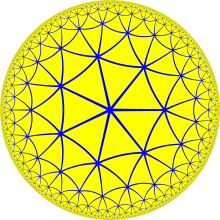Klein quartic
The Klein quartic is a curve of degree 4 in the complex projective plane , in homogeneous coordinates by the equation
given is.
It was introduced by Felix Klein in 1879 and has exceptional symmetry properties. The algebraic curve corresponds to a Riemann surface .
The symmetry properties result from tiling the hyperbolic plane with heptagons , so that exactly three collide at each corner (therefore named). From exactly 24 of these heptagons a torus with 3 holes can be formed, the Klein surface , topologically of genus 3. There are 24 transformations of the tiling with 24 heptagons into one another and for each 7 rotations of the heptagon, which results in 168 symmetry operations (with double reflections so many, 336). If you subdivide the heptagons into triangles, you get the ( Poincaré -) dual tiling (7 triangles meet at each corner) and the area for the small quarters can also be formed from 56 triangles of this tiling. 56 transformations of the triangles into other triangles and three rotations each result in 168 transformations.
This is also the maximum number of symmetries for surfaces of gender 3, as Adolf Hurwitz showed ( Hurwitz's theorem on automorphism groups ): A Riemann surface of gender has maximally conformal transformations (without reflections). The conformal mappings can be represented by broken-linear maps ( Möbius transformations ) and form the projective special linear group . It consists of complex 2 × 2 matrices with determinant 1, where matrices and are identified.
If one considers the hyperbolic plane as a complex upper half-plane on which acts, then the Riemann surface for the Klein quartic is given by
with the congruence subgroup
It is a modular curve (with gender 3 and 24 tips , see module form ).
Its symmetry group is and has 168 elements (without reflections that would not preserve the complex structure). It is also the symmetry group of the Fano plane and the second smallest simple non-Abelian group. Only the icosahedron group that Felix Klein treated in connection with the fifth degree equation and the symmetry group of the icosahedron is even smaller (it has 60 elements).
Since their symmetry group cannot be embedded in the three-dimensional rotating group SO (3), there are no three-dimensional realizations of the Klein Quartik, but there are representations of their shape, for example a sculpture by Helaman Ferguson in front of the MSRI in Berkeley.
literature
- Silvio Levy (Ed.): The Eightfold Way: The Beauty of Klein's Quartic Curve, Cambridge UP 1999, online
Web links
- Klein Quartic , Mathworld
- John Baez, Klein's Quartic Curve
Individual evidence
- ↑ Klein, About the transformations of the seventh order of the elliptical functions , Mathematische Annalen, Volume 14, 1879, pp. 428-471, reprint in the collected treatises, Springer, Volume 3, pp. 90-136, digitized, Sub Göttingen


















